Everyone loves a top ten list so we thought it would be fun to share the top 10 accomplishments for our rivers and waters that you helped make possible by being part of the NSRWA community!
1. Greening the North River Greenway
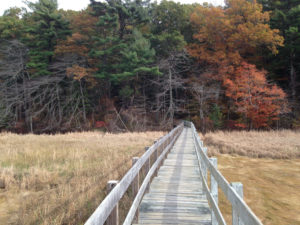
In 2010 the NSRWA supported the acquisition of the Little’s and Goggin Conservation areas along the North River in Marshfield. This 75-acre woodland complex abuts the North River with trails that lead to the river and a dock for accessing the water. This keystone conservation land is part of a larger puzzle we and partners have been working on since 2000 to preserve hundreds of acres of contiguous lands abutting the mainstem of the North River. In 2013 an additional 11 acres was added to the North River Greenway Conservation Corridor when Norwell acquired a property abutting the North River at the end of Masthead Lane. This property still requires parking and trail upgrades to make it accessible to the public. Let’s see if we can get that done in the next decade!
2. Beginning of a South River Greenway
In 2012 the South River Park opened on what was a commercial property along the South River in 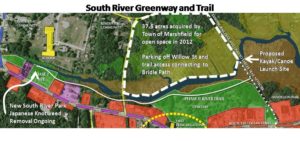 downtown Marshfield. This park adds to other green spaces along the South River like Molly Park and Veteran’s Park. In 2012 the 37 acre Pratt Farm conservation area was acquired that abuts the South River and the rail trail. These urban oases provide much needed green spaces and views to the South River in an otherwise busy urbanized area that had relegated the South River to the back of gas stations. There is more to do to maintain these new parks and we hope in the future to link them with a walkway along the South River.
downtown Marshfield. This park adds to other green spaces along the South River like Molly Park and Veteran’s Park. In 2012 the 37 acre Pratt Farm conservation area was acquired that abuts the South River and the rail trail. These urban oases provide much needed green spaces and views to the South River in an otherwise busy urbanized area that had relegated the South River to the back of gas stations. There is more to do to maintain these new parks and we hope in the future to link them with a walkway along the South River.
3. South River Shellfish Beds Opened
After 30 years of being closed due to poor water quality, the South River Shellfish beds were opened in 2011. The 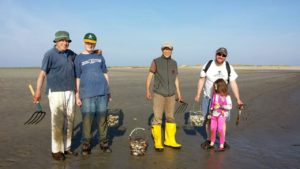 opening of the shellfish beds was the culmination of years of work by the NSRWA in the previous decade to sewer failing septic systems in Marshfield and upgrade stormwater infrastructure to prevent pollution from runoff. The South River shellfish beds were opened December 1 through May 31st like the North River beds. In 2013 water quality sampling indicated that it had improved so that the shellfishing season could be extended to open one month earlier on November 1st. This year they opened even earlier in October! Our ultimate goal is to improve water quality through stormwater education and infrastructure upgrades so that the shellfish beds can be opened to harvest year-round in the next decade.
opening of the shellfish beds was the culmination of years of work by the NSRWA in the previous decade to sewer failing septic systems in Marshfield and upgrade stormwater infrastructure to prevent pollution from runoff. The South River shellfish beds were opened December 1 through May 31st like the North River beds. In 2013 water quality sampling indicated that it had improved so that the shellfishing season could be extended to open one month earlier on November 1st. This year they opened even earlier in October! Our ultimate goal is to improve water quality through stormwater education and infrastructure upgrades so that the shellfish beds can be opened to harvest year-round in the next decade.
4. Improving Access to the South River
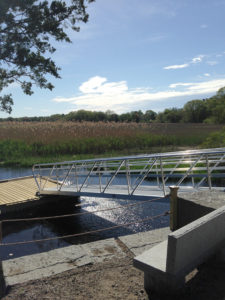 In 2017 along with improvements to trails and parking at the Pratt Farm conservation area, the NSRWA successfully advocated for the addition of a canoe and kayak access dock on the South River in Marshfield. Located on the Francis Keville Footbridge on of the Rail Trail, this new kayak and canoe launch enables people to get in at the top of the South River’s most navigable point and travel the tidal portion of the river down to the mouth! By improving access to the South River and developing a greenway along the river we hope to highlight just how beautiful this natural resource is for all to enjoy!
In 2017 along with improvements to trails and parking at the Pratt Farm conservation area, the NSRWA successfully advocated for the addition of a canoe and kayak access dock on the South River in Marshfield. Located on the Francis Keville Footbridge on of the Rail Trail, this new kayak and canoe launch enables people to get in at the top of the South River’s most navigable point and travel the tidal portion of the river down to the mouth! By improving access to the South River and developing a greenway along the river we hope to highlight just how beautiful this natural resource is for all to enjoy!
5. Increasing Citizen Science to Monitor the Health of Our Waters
The NSRWA grounds its work to protect and restore the environment in science. Long time citizen science programs include horseshoe crab monitoring in Duxbury Bay through our partnership with the MassBays Partnership and our RiverWatch water quality monitoring program 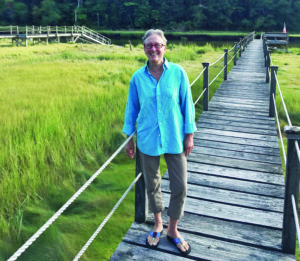 that has been sampling water quality for over 25 years. In 2012 the NSRWA started a new citizen science program to count river herring as they returned to our rivers. Now every year hundreds of citizens help to count river herring in the spring at four locations – Herring Brook in Pembroke, South River in Marshfield, First Herring Brook in Scituate and Third Herring Brook in Norwell and Hanover. In 2018 and 2019 respectively we added Bound Brook in Scituate and Cohasset where a dam was recently removed and the Weir River in Hingham. Collecting this data is crucial to informing decisions on restoration efforts for this species and helps us to understand how dam removals and fish ladders are working (or not!).
that has been sampling water quality for over 25 years. In 2012 the NSRWA started a new citizen science program to count river herring as they returned to our rivers. Now every year hundreds of citizens help to count river herring in the spring at four locations – Herring Brook in Pembroke, South River in Marshfield, First Herring Brook in Scituate and Third Herring Brook in Norwell and Hanover. In 2018 and 2019 respectively we added Bound Brook in Scituate and Cohasset where a dam was recently removed and the Weir River in Hingham. Collecting this data is crucial to informing decisions on restoration efforts for this species and helps us to understand how dam removals and fish ladders are working (or not!).
In 2017 we started new citizen science program called Salt Marsh Sentinels to monitor the health of our salt marshes, which are of particular concern as climate change-driven sea level rise accelerates. This program engages dock owners to use their docks as a fixed ruler to measure changes in vegetation and erosion along our marshes. And in 2018 and 2019, through our partnership with the MassBays program, we began another program to monitor Eelgrass Beds in Duxbury Bay to understand recent major losses of this habitat in the bay.
6. Saving Water for People and Rivers
In 2011 the NSRWA advocated successfully for the town of Scituate to put in place a lawn irrigation restriction that 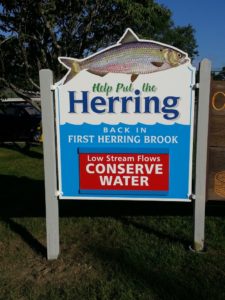 saved 300,000 gallons per day during the summer months. We advocated for this to help restore flows to the First Herring Brook in Scituate because over time the town had operated the reservoir dams to no longer allow flow out of the reservoirs during the summer and fall months when out-migrating herring need to return to the sea. This effectively extinguished the local population of herring in this tributary. In 2012, through a flow release plan and monitoring, the NSRWA observed the first return of river herring to this system in decades up the fish ladder and into Old Oaken Bucket Pond. The NSRWA has continued to work with the town of Scituate to make their water supply more resilient to drought while at the same time maintaining a fishery within the system. Current work involves making the upper reservoir accessible to fish and raising the reservoir to increase its storage for drought. Our thinking… a healthy river is a good sign of a healthy water supply.
saved 300,000 gallons per day during the summer months. We advocated for this to help restore flows to the First Herring Brook in Scituate because over time the town had operated the reservoir dams to no longer allow flow out of the reservoirs during the summer and fall months when out-migrating herring need to return to the sea. This effectively extinguished the local population of herring in this tributary. In 2012, through a flow release plan and monitoring, the NSRWA observed the first return of river herring to this system in decades up the fish ladder and into Old Oaken Bucket Pond. The NSRWA has continued to work with the town of Scituate to make their water supply more resilient to drought while at the same time maintaining a fishery within the system. Current work involves making the upper reservoir accessible to fish and raising the reservoir to increase its storage for drought. Our thinking… a healthy river is a good sign of a healthy water supply.
7. Estuary Explorers and Pontoon Boat Tours
In 2015 the NSRWA was given a pontoon boat by the Vercollone family and Roht Marine generously offered to keep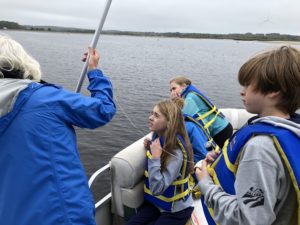 it at their marina on the North River free of charge. These acts of generosity have enabled thousands of people and children to be able to see the beauty of and learn about the rich human and natural history of these famous rivers through our guided pontoon boat tours. In 2016 we began our Estuary Explorers program and partnered with other youth-based organizations to take children out to explore how scientists monitor and protect estuaries. Connecting people to the rivers and our local waters is the best way to save them. Now we take over 500 local families and children out on our boat to enjoy and learn about our rivers annually!
it at their marina on the North River free of charge. These acts of generosity have enabled thousands of people and children to be able to see the beauty of and learn about the rich human and natural history of these famous rivers through our guided pontoon boat tours. In 2016 we began our Estuary Explorers program and partnered with other youth-based organizations to take children out to explore how scientists monitor and protect estuaries. Connecting people to the rivers and our local waters is the best way to save them. Now we take over 500 local families and children out on our boat to enjoy and learn about our rivers annually!
8. Increasing Environmental Education
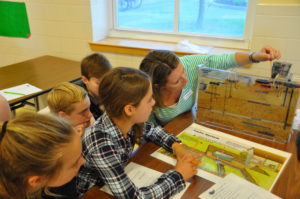 In 2010 we began in earnest our 5th grade Water All Around You program with our regional town WaterSmart partners that now reaches children in 12 South Shore towns. In the past decade, we have reached over 20,000 schoolchildren with this program! In late 2018 the NSRWA hired our first full-time environmental educator to allow us to develop new programs to connect with middle and high school age students which just this last year enabled us to double the number of children we engage with their local waters. We are excited about this new capacity that our Campaign for Growth has allowed and can’t wait to see what the next decade brings for increasing our educational programming!
In 2010 we began in earnest our 5th grade Water All Around You program with our regional town WaterSmart partners that now reaches children in 12 South Shore towns. In the past decade, we have reached over 20,000 schoolchildren with this program! In late 2018 the NSRWA hired our first full-time environmental educator to allow us to develop new programs to connect with middle and high school age students which just this last year enabled us to double the number of children we engage with their local waters. We are excited about this new capacity that our Campaign for Growth has allowed and can’t wait to see what the next decade brings for increasing our educational programming!
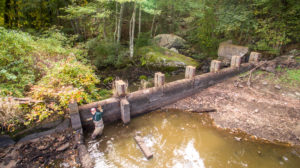 9. Restoring 9 Miles of Free-Flowing Rivers
9. Restoring 9 Miles of Free-Flowing Rivers
Restoring our environment can feel like it takes a long time but nature is very responsive when we work with her! In 2014 and 2017 the NSRWA took out two dams on the Third Herring Brook and in 2016 worked on removing an unneeded culvert on the Iron Mine Brook – all of these were blocking fish and free-flowing rivers – one of the most endangered habitats on the planet! Since removing the dams on the Third Herring Brook we have seen river herring spawning upstream of where the dams were for the first time in over 300 years!
10. Monitored the Return of Native Brook Trout Leading to Protections
We have monitored the return of native Brook Trout – another species whose populations are in trouble- to the mainstem of the Third Herring Brook. Finding the brook trout resulted in further protections of the Third Herring Brook as a Cold Water Fishery Resource which has led to requirements for increased stormwater treatment from development projects like the soon to be redeveloped Hanover Mall. Next year we hope to remove the third dam on the Third Herring Brook in partnership with Hanover Mall and continue to restore herring to the brook whose is its namesake.
If you supported this work by donating your time and treasure these are your accomplishments too! Thank you! Please help us keep the momentum going by donating to help us start the next decade strong and making the 2020s as successful.


